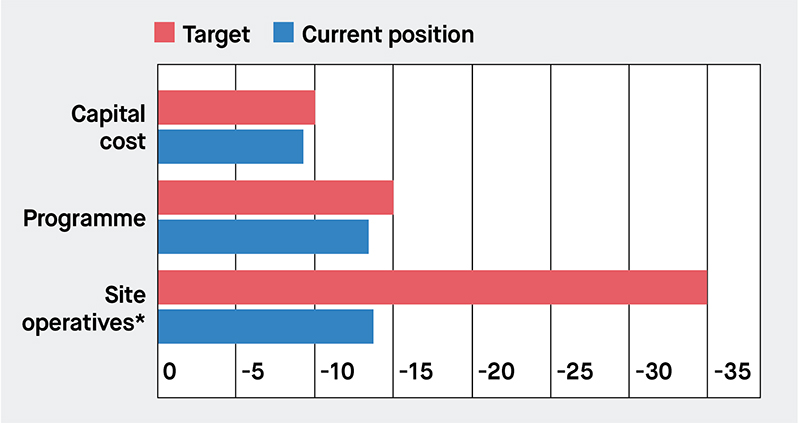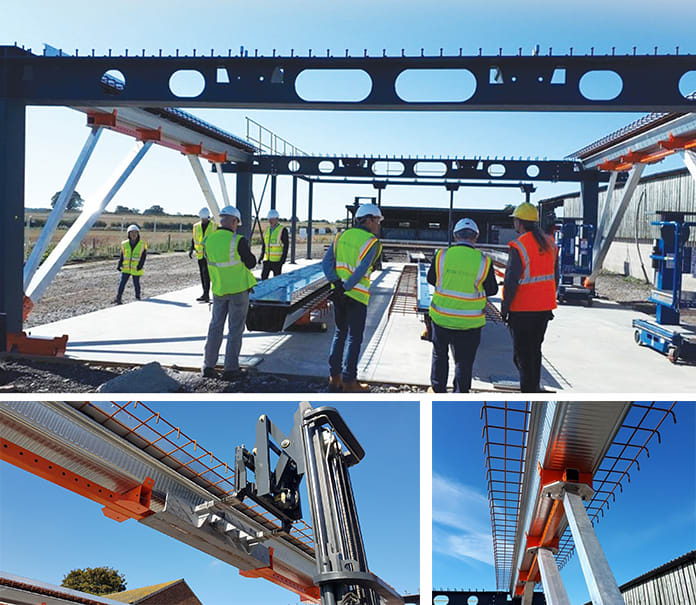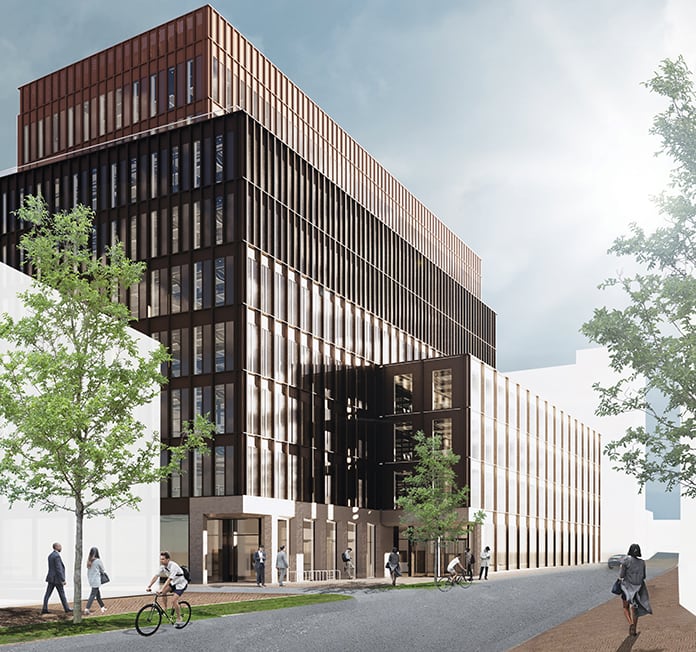Platform DfMA – a componentised approach to construction – is getting its first private sector run-out on a London office job. Developer Landsec and design partner Bryden Wood explain the thinking to Will Mann.
Landsec, one of the UK’s largest commercial property developers, is working with integrated design practice Bryden Wood on a London office scheme which could transform how construction projects are procured, designed and constructed.
Benchmarked against Landsec’s typical costs per sq m, the project – currently at design stage – is already achieving impressive efficiency gains: a predicted 9.5% reduction in capital cost against a target of 10%, and a 13% reduction in programme against a target of 15%.
This is the first ‘real world’ application of P-DfMA (platform design for manufacture and assembly) in the private sector – essentially a more standardised, componentised approach to construction. Landsec and Bryden Wood have already built a prototype at the practice’s Construction Platforms Research Centre in Petersfield, Hampshire, working with offsite specialist Easi-Space, which was backed by Innovate UK research funding.
Now the principles of this ‘kit of parts’ approach are being tested on a Landsec office development at Sumner Street in Southwark.
“Our aim is to become a fundamentally different developer,” says Neil Pennell, head of design innovation and property solutions at Landsec. “Digital is the enabler here. It is possible to experiment and prototype much more quickly, so being a follower isn’t an option. You have to innovate and lead to stay ahead of the competition.
“This is not about creating identikit buildings that look the same,” he adds, addressing some architects’ fear about P-DfMA. “This approach retains the architect’s creative freedom. Despite the kit of parts being standardised, these can be put together in countless ways to create a huge range of different spaces and aesthetics, without limiting design ambition.”

Integrating services within the platform allows increased perimeter glazing, improving daylight penetration
Landsec calls its approach Office 1.0. This may seem an unusual term, but it is actually a clever way for the developer to benchmark the costs of delivering a construction project against its desired return on investment from a site.
“1.0 is the construction cost of a ‘perfect’ site, where we can maximise efficiencies in materials, programming and construction,” explains Pennell. “Where there are, for example, onerous planning requirements or difficult ground conditions, the cost may rise to 1.2 or 1.3 times that baseline cost. It’s a useful ready reckoner, when assessing the rate of return on a site.”
To create the Office 1.0 strategy, Landsec asked Bryden Wood to analyse a number of office schemes and identify common design themes which would form the basis of the platform strategy.
“We like to create an evidence base,” says Jaimie Johnston, global systems director at Bryden Wood. “We found, for instance that most offices in London have a 1.5m planning grid, and they tend to have a structural grid ranging from 9m x 9m to 9m x 12m.
“And if you look at the British Council for Offices [BCO] guide for design best practice, this is in line with what they recommend. But architects and designers don’t always follow it. The structural grid might be 9.1m x 9.1m or 8.9m x 8.9m, and then you lose the opportunity for standardisation of components.
“Of course, most sites are not perfect, but if you need to include any bespoke requirement in the design, that can be kept to one end of the structural grid, so you can have high standardisation throughout the rest of it.”
105 Sumner Street is a 135,000 sq ft office development behind the Tate Modern, across two nine-floor buildings. Bryden Wood is the architect, structural engineer, building services engineer and sustainability consultant. The scheme had been taken to RIBA stage 3 using a traditional design, with planning permission granted, when Landsec decided to use it as a pilot project.

We are looking at a form of construction management (CM). But this role will require the skill set of a consultant, a constructor, a logistics manager – all the skills needed to make a site run like a factory and with a multi-skilled workforce that can step up to that way of working.– Jaimie Johnston, Bryden Wood
“What we have done is taken the kit of parts and applied it to a traditional design, which is a good test for the platform approach, showing that it can satisfy planning requirements, while making a direct comparison with traditional construction methods,” says Johnston. “There are a few local planning conditions, relating to the building massing and steps in the facade, so this has set a good challenge for the team to meet using the kit of parts solution. It won’t quite equate to the Office 1.0 perfect benchmark, but we have been able to achieve over 80% standardisation in the products used in our design.”
Sumner Street is using a different procurement approach (see box), with key supply chain members brought in early to help identify innovation and efficiency gains.
The structural design has been re-engineered from five different floor heights to just two to promote repeatability, while instead of a conventional perimeter grid with beefy columns every 9m, ‘micro’ columns have been introduced 3m apart to reduce the structural zone. “These take up less area and disappear into the wall build-up,” explains Johnston.
With P-DfMA, building services are integrated within the platform design, enabling more efficient use of space. “At Sumner Street, this allowed increased clear height within the space and the opportunity to increase the height of the perimeter glazing to improve daylight penetration onto the floorplate,” says Johnston.
The on-floor MEP kit of parts has been designed to integrate with the superstructure, using fixings pre-cast into the concrete slabs, minimising the need to drill the slab to create supports for the services modules. “This reduces the need to work at height and almost eliminates drilling and the dust it produces, creating a healthier and safer site to work on,” says Johnston.
The MEP modules have been designed to work with the all-electric central plant, using high-efficiency heat pumps to meet heating and cooling requirements, a key part of the zero carbon in use strategy.
“Taking a leaf from the car manufact-urers’ book, alternative on-floor climate control systems will be developed using fan coil units, active and passive chilled beams, allowing customers to choose a system much as a car purchaser would select options – an early demonstration of how mass customisation techniques could be applied,” adds Johnston.
Deflection on the floor slabs has been reduced by the ribbed design of the concrete slab and, at the perimeter, the use of columns at 3m centres. This helps with installation of the facade which has a regularised design to suit the structural frame.
“With cladding, a common problem is the perimeter floor slab deflects or the construction tolerances generally are slightly out, so it becomes harder to make pre-manufactured components work,” says Johnston.
“Using a repeatable, manufactured kit of parts allows us to improve the accuracy of the structural components so we can be more confident the cladding panels will fit first time. We’ve also reduced slab deflection by replacing the usual glazing mullions with the micro columns which perform structurally, so the span is reduced by a third from 9m to 3m.

How Landsec is benchmarking efficiency improvements at Sumner Street

*For the two key P-DfMA packages checked so far, structure and cladding, Landsec believes that the predicted productivity gains will see a reduction in the size of site install teams of around 50% for these elements. However, as these only represent part of the project, the overall reduction to date stands at 13.5%. Once the scope of the kit of parts is expanded, Landsec expects to hit the 35% target.

“Cladding comes typically in 1.5m-wide modules to suit the planning grid but we wanted to see if, through using larger 3 or 6m panels, we could reduce the number of onsite joints and speed up the installation process.
“With 3m panels, we will be able to cover 84% of the facade – a pretty good level of standardisation. We may yet end up with smaller panels, so we can have standardisation over a larger area. But we will go through a learning process with this kit of parts approach and understand what is optimum.”
The combination of greater levels of standardisation, reduced construction tolerances and a more direct procurement approach is already achieving a significant reduction in cladding costs, says Pennell.
Another benefit to the quality of the space being created has come through optimising both the amount and solar performance level of the glass in the facade. The digital model has made it easier to simulate and “tune” the building performance, which informs the MEP installation and the glazing performance requirements, says Johnston.
“Because we have the components digitally in the model, we were able to test the energy balance very quickly and found that the reduced structural zone allowed us to increase glazing and improve the daylighting without incurring any significant energy penalty,” he explains.

A prototype was tested at Bryden Wood’s Hampshire research centre
One consequence of the kit of parts approach is to bring manufacturers closer to the end user. “More of our convers-ations will be direct with the suppliers and manufacturers,” says Pennell.
“This means manufacturers gain more ability to innovate and influence the design, and that opens up possibilities for more efficiencies,” says Johnston. “For example, a steel frame is priced per tonne without considering the level of fabrication. But how about if all the steel components on a project are highly standardised and most need very little fabrication? The steel supplier is likely to say, yes, we can probably knock some money off.”
Other innovation will come through the assembly process, Pennell continues.
“Building sites depend a lot on tower crane use,” he notes. “But because we re-engineered the structural design at Sumner Street, we believe we can use smaller lifting equipment to raise the main components into place. We have been testing these ideas on the prototype using a modified reach stacker commonly used in warehouses to lift concrete beam formwork into place.
“Our prototyping partners Easi-Space have also developed lightweight vertical facade lifters which fix onto the perimeter micro-columns taking advantage of their structural performance to transfer the loads efficiently into the main frame rather than onto the floor slabs using the larger and heavier counterweighted lifting machines typically deployed.”
With this approach, Pennell predicts a 10% cost saving overall. “Yes, the increased focus on offsite manufacture means we have to bring forward some spending in the programme, but we believe the overall cost of the project will be reduced. When you factor in the health and safety benefits, quality improvements and programme savings the business case is compelling.”
Overall cost savings
There are also impressive sustainability gains, with a forecast 19.4% reduction in embodied carbon per sq m overall in the P-DfMA design. There has been a 36.4% carbon reduction in the substructure and a 20.2% reduction in the superstructure and facade.
“And we will take the learning here to other projects – the same structural and MEP components and the same design and procurement principles can be used again,” says Pennell. “This is our first kit of parts project – by the time we’re on our third or fourth project, we will be achieving higher levels of standardisation which should lead to even greater benefits.”
Landsec’s strategy here is simply a response to disruption in the wider built environment sector, says Pennell. “We are already seeing specialist global offsite manufacturing companies entering the UK construction market,” he notes.
“The innovation in digital design and the application of modern methods of construction is happening in construction all round the world. The UK construction industry is respected globally but if we want to maintain and ideally improve our position, we need to keep innovating.”
Meanwhile, Bryden Wood is taking the principles of Office 1.0 into the housing market. “A client has asked us to create ‘Apartment 1.0’,” says Johnston.

The facade of Landsec’s Sumner Street office development has a regularised design to suit the structural frame
MAM’s the word: a new procurement approach
Landsec has appointed Mace and Sir Robert McAlpine as ‘manufacturing and assembly managers’ on Sumner Street
The kit of parts approach has meant a “fundamental change in our approach to procurement”, says Pennell.
“The model the industry has defaulted to is based around design and build, where responsibility to complete the building design is passed down the supply chain. It has been driven by a desire to protect investment returns and transfer risk. But it has become a barrier to innovation. And also, it restricts clients from exerting influence once responsibility has been passed to the contractor – which is madness. Would BMW hand over the design of one of their cars to another manufacturer to finish?
“So, we are looking at a form of construction management (CM). But this role will require the skill set of a consultant, a constructor, a logistics manager – all the skills needed to make a site run like a factory and with a multi-skilled workforce that can step up to that way of working.
“We’ve called this procurement model ‘manufacturing and assembly management’ (MAM). We have appointed two companies in this new role for the Sumner Street project: Sir Robert McAlpine and Mace. Some people may think that the MAM acronym comes from the company initials, but this is, as they say, entirely coincidental.
“The important thing is that they are working collaboratively, to manage the risk, not hide it or push it on to someone else and help to grow the supply chain capability to deliver projects in this way. Finding two industry leading constructors willing to work together to help us develop this model has been great.”
Both McAlpine and Mace have been working with Landsec in Bryden Wood’s office since the start of 2019, under a pre-construction agreement which also brought on board key suppliers including: Aggregate Industries, Tata Steel, Aluprof, Hall & Kay, Hotchkiss, NG Bailey, Kone, LaserCell and Trimble.
“Landsec were prepared to share the risk on the project in exchange for lower prices and more direct control,” says Johnston. “This also opened up the supply chain to new, different and smaller players – such as Easi-Space.”
The effect on Sumner Street has been to achieve “earlier design resolution and more cost-effective outcomes”, he adds.















